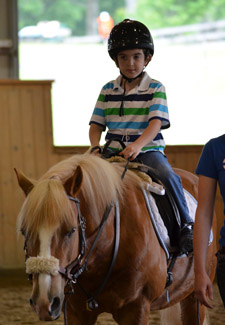Miracle Workers: Therapy Horses at Work
Published on July 11, 2013

Nearly everyone is familiar with therapy dogs, who visit hospitals, nursing homes, disaster victims and even universities during finals week to provide comfort and lower stress. But did you know there are also therapy horses? There are — and they can help with more than just emotional well-being.
The horses at Maryland Therapeutic Riding (MTR) work in two basic programs. One is hippotherapy, which is performed by licensed physical, speech and occupational therapists. "They're using the horse's movement as a therapy tool, just as they'd use a ball in a clinical setting," says Kelly Rodgers, program director.
The other program is therapeutic riding, where certified instructors teach riding skills to people with a wide range of disabilities, including autism, cerebral palsy and PTSD.
"It takes a very special horse to do this job," Rodgers says.
The Job Description
One fundamental quality these horses need is the ability to be comfortable with a wide range of people. More than 150 volunteers assist in the programs, and clients can be kids or adults, some using canes or wheelchairs. "There are riders that might have balance problems or behavior problems," Rodgers says. "[The horses] have to deal with a lot of different noises."
The riding tasks can also be unusual. Some riders use an automatic lift to help them mount a horse. "The therapists may have the client ride backward or sideways — a lot of things that are not very natural for a horse," she says. "In our lessons we have some clients who need full support — that means someone leading the horse and someone on each side of the horse."
Rodgers says many of their horses are retiring from another career, such as show jumping or trail riding, but the organization generally doesn't use older horses as some people expect, since it's actually a very physically demanding job.
"In a regular setting, they have riders that can balance themselves and can carry their weight," she says. "This is different for them, so it's important that the horse is 100 percent sound and physically fit." They're kept that way with a strict exercise schedule to get the kind of workout they don't get in lessons, and close attention is paid to their nutrition, health and saddle fitting. In addition, the horses are kept up-to-date with all vaccinations and farrier and veterinary care.
MTR doesn't generally own their horses. Most are on a free lease from their owners, and the organization takes care of all their expenses for as long as they're working. "It's a nice arrangement for both parties," Rodgers says. The owners still have some connection — some come and ride regularly — and when the horses end their careers, they can go back to their owners, eliminating the difficult task of finding a retirement home.
A potential horse starts with a 60-day trial period. "We do mock lessons," she says. "Nothing can perfectly simulate what they will see in the real-life program, but we do our best to put them through everything." Then, when the horses are ready, they start them with a couple of lessons a week and increase gradually.
The Best Breeds for the Job
Rodgers says that certain breeds of horses are generally right — or not right — for the job. Quarter horses, which they have four of at the moment, are good because they tend to be "stocky, level-headed and quiet," she says. The organization typically won't take something like a Thoroughbred: "They're bred for racing — we want them slow."
While the horses need to share certain basic qualities, they are still different horses with different personalities. One businesslike fellow is a pony called Bob, who came to them about a year ago. "He was dead quiet, he was good, he seemed to like his job," she says. "He was probably the fastest we've ever been able to get into the program. He was actively in lessons within the first month and a half."

A flashier guy is a quarter horse called Apollo. "He's got this aura about him — he's like a stud, a big personality — but you can tell he really loves his job," she says. "He knows when to turn it on. He can tell when to be the therapy horse that he needs to be and when to challenge his riders."
Healing Bodies and Minds
Whatever breed or personality of the horses, working with them can have amazing effects on clients, both physically and mentally.
"I saw one little boy who was 4 years old and had never walked. He wasn't even crawling much," Rodgers says. "After just a few sessions with one of our physical therapists in our hippotherapy program, he was taking his first steps."
And simply learning to ride in the therapeutic riding program can work wonders as well. Rodgers once saw another little boy who was nonverbal say his first words in a riding lesson. "That wasn't the instructor's goal," she says. But the connection the boy had developed with the horse brought that out.
Rodgers seems almost a little embarrassed at how magical it sounds, but, she says, "There is something special about the horses — it's that silent language you're speaking with them. We literally see miracles all the time."
Other Vetstreet articles about service and therapy animals:
"I Train Guide Dogs for the Blind"
Injured Veterans Train Service Dogs for Fellow Soldiers
Lucas and Juno: The Special Relationship Between a Sick 4-Year-Old Boy and His Dog





